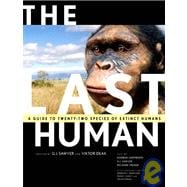
Note: Supplemental materials are not guaranteed with Rental or Used book purchases.
Purchase Benefits
What is included with this book?
| Foreword | p. 16 |
| We Were Not Alone: Introduction | p. 18 |
| Twenty-Two Species of Extinct Human Ancestors | p. 24 |
| The Earliest African Hominids | |
| Morning Encounters | |
| Sahelanthropus tchadensis | p. 29 |
| Orrorin tugenensis | p. 34 |
| Ardipithecus ramidus and kadabba | p. 39 |
| Omo, Lake Turkana, and Awash Basins and the Appearance of the Human Lineage | |
| A Much Welcomed Visit | |
| Australopithecus anamensis | p. 50 |
| We Are Family | |
| Kenyanthropus platyops | p. 58 |
| The First Nomad? | |
| Australopithecus afarensis | p. 65 |
| Dispatching a Mortal Enemy | |
| Paranthropus aethiopicus | p. 79 |
| The First Tool-Using Scavenger? | |
| Australopithecus garhi | p. 87 |
| The South African Fossil Caves Sites | |
| The Animal Trap | |
| Australopithecus africanus | p. 96 |
| To Live and Die on the High Veldt | |
| Paranthropus robustus/crassidens | p. 107 |
| Back to the East African Great Rift Valley and the Appearance of Homo | |
| A Two Leg Advantage | |
| Homo rudolfensis | p. 117 |
| The Luck of the Pygmy | |
| Homo habilis | p. 124 |
| In the Shadow of Man | |
| Paranthropus boisei | p. 133 |
| When Opportunity Knocks | |
| Homo ergaster | p. 141 |
| From Africa to Asia? | |
| A Handful of Know-How | |
| Homo georgicus | p. 151 |
| Eve Without Adam | |
| Homo erectus | p. 158 |
| A Winter Night's Desperation | |
| Homo pekinensis | p. 168 |
| An Island Sunset for the Little People | |
| Homo floresiensis | p. 176 |
| Africa, Europe, and then the World | |
| The Ultimate Competitor | |
| Homo antecessor | p. 185 |
| How to Grow a Sugarplum Tree | |
| Homo rhodesiensis | p. 194 |
| Greed and Equality | |
| Homo heldelbergensis | p. 201 |
| Hunters and Hunted | |
| Homo neanderthalensis | p. 210 |
| Then There Was One | |
| Homo sapiens | p. 222 |
| Afterword | p. 230 |
| The Search for Faces of the Past | p. 232 |
| Portraits of Prehistory: Imaging Our Ancestors | p. 237 |
| Further Reading | p. 251 |
| Acknowledgments | p. 252 |
| Index | p. 253 |
| Table of Contents provided by Ingram. All Rights Reserved. |
The New copy of this book will include any supplemental materials advertised. Please check the title of the book to determine if it should include any access cards, study guides, lab manuals, CDs, etc.
The Used, Rental and eBook copies of this book are not guaranteed to include any supplemental materials. Typically, only the book itself is included. This is true even if the title states it includes any access cards, study guides, lab manuals, CDs, etc.